ASSIGNMENT ON CORPORATE AUDITING.
Added on 2022-09-14
26 Pages6495 Words10 Views
Running head: CORPORATE AUDITING
Corporate Auditing
Name of the Student
Name of the University
Author’s Note
Corporate Auditing
Name of the Student
Name of the University
Author’s Note
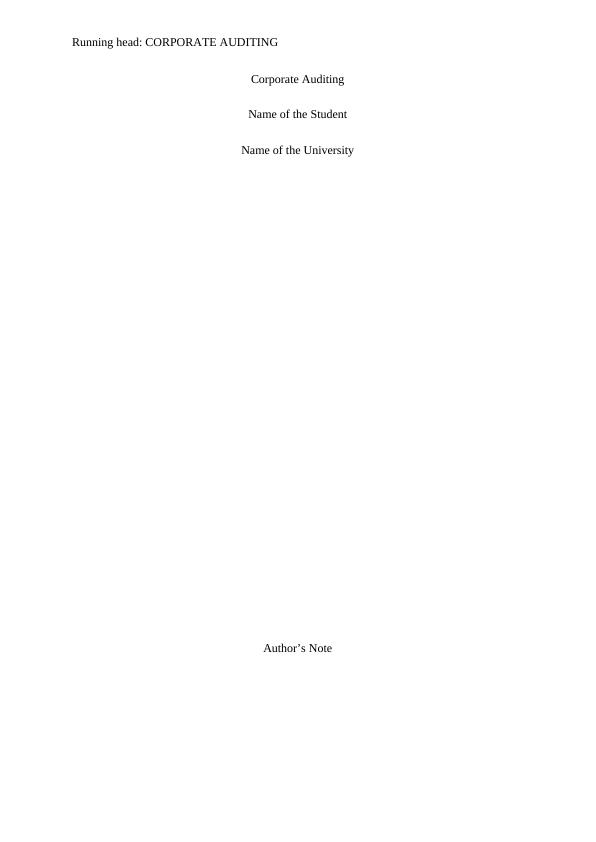
1CORPORATE AUDITING
Table of Contents
Part A.........................................................................................................................................2
Introduction............................................................................................................................2
Types of Companies Subject to Audit under AAS and Corporations Act.............................2
Advantages of Company Audits Subject to One Set of Auditing Standards.........................3
Disadvantages of Company Audits Subject to One Set of Auditing Standards.....................5
Conclusion..............................................................................................................................6
Part B..........................................................................................................................................7
Audit Planning Memorandum................................................................................................7
References................................................................................................................................14
Appendix..................................................................................................................................17
Table of Contents
Part A.........................................................................................................................................2
Introduction............................................................................................................................2
Types of Companies Subject to Audit under AAS and Corporations Act.............................2
Advantages of Company Audits Subject to One Set of Auditing Standards.........................3
Disadvantages of Company Audits Subject to One Set of Auditing Standards.....................5
Conclusion..............................................................................................................................6
Part B..........................................................................................................................................7
Audit Planning Memorandum................................................................................................7
References................................................................................................................................14
Appendix..................................................................................................................................17
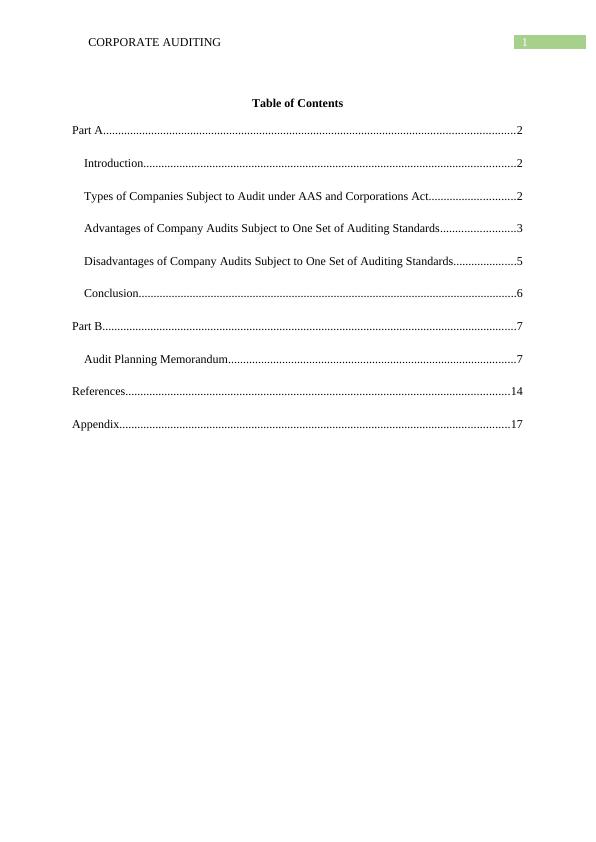
2CORPORATE AUDITING
Part A
Introduction
It is required for the business organizations to prepare and present their audited
financial statements so that the users can assess the actual financial performance and position
of them. In this process, the auditors need to comply with the required auditing standards and
principles for auditing the financial statements of the companies. In the recent years, key
attempts have been taken for the development of a single set of auditing standards for all
types of companies (Ismail and Mustapha 2015). In Australia, the obligation on the
companies is to comply with the auditing standards of the Australian Auditing Standards
under Corporations Act (2001). There are three major parts of this report. The first part
discusses about the list of companies that are subject to audit under Australian Auditing
Standards under Corporations Act (2001). The next two parts discusses about the advantages
and disadvantages of having a single set of auditing standards for all the companies. Lastly, a
conclusion is provided based on the whole discussion.
Types of Companies Subject to Audit under AAS and Corporations Act
In Australia, different types of companies are subject to an audit in accordance with
the Australian Auditing Standards under the Corporations Act (2001). They are discussed
below:
In case an entity is a disclosing entity or registered under the registration scheme of
the Corporations Act (2001), it is subject to an audit in accordance with the Australian
Auditing Standards under Corporations Act (2001).
The public entities in Australia that are limited by guarantee are subject to an audit as
per the above-mentioned standards. Moreover, the Australian small companies that
are limited by guarantee are subject to audit in compliance with the Australian
Part A
Introduction
It is required for the business organizations to prepare and present their audited
financial statements so that the users can assess the actual financial performance and position
of them. In this process, the auditors need to comply with the required auditing standards and
principles for auditing the financial statements of the companies. In the recent years, key
attempts have been taken for the development of a single set of auditing standards for all
types of companies (Ismail and Mustapha 2015). In Australia, the obligation on the
companies is to comply with the auditing standards of the Australian Auditing Standards
under Corporations Act (2001). There are three major parts of this report. The first part
discusses about the list of companies that are subject to audit under Australian Auditing
Standards under Corporations Act (2001). The next two parts discusses about the advantages
and disadvantages of having a single set of auditing standards for all the companies. Lastly, a
conclusion is provided based on the whole discussion.
Types of Companies Subject to Audit under AAS and Corporations Act
In Australia, different types of companies are subject to an audit in accordance with
the Australian Auditing Standards under the Corporations Act (2001). They are discussed
below:
In case an entity is a disclosing entity or registered under the registration scheme of
the Corporations Act (2001), it is subject to an audit in accordance with the Australian
Auditing Standards under Corporations Act (2001).
The public entities in Australia that are limited by guarantee are subject to an audit as
per the above-mentioned standards. Moreover, the Australian small companies that
are limited by guarantee are subject to audit in compliance with the Australian
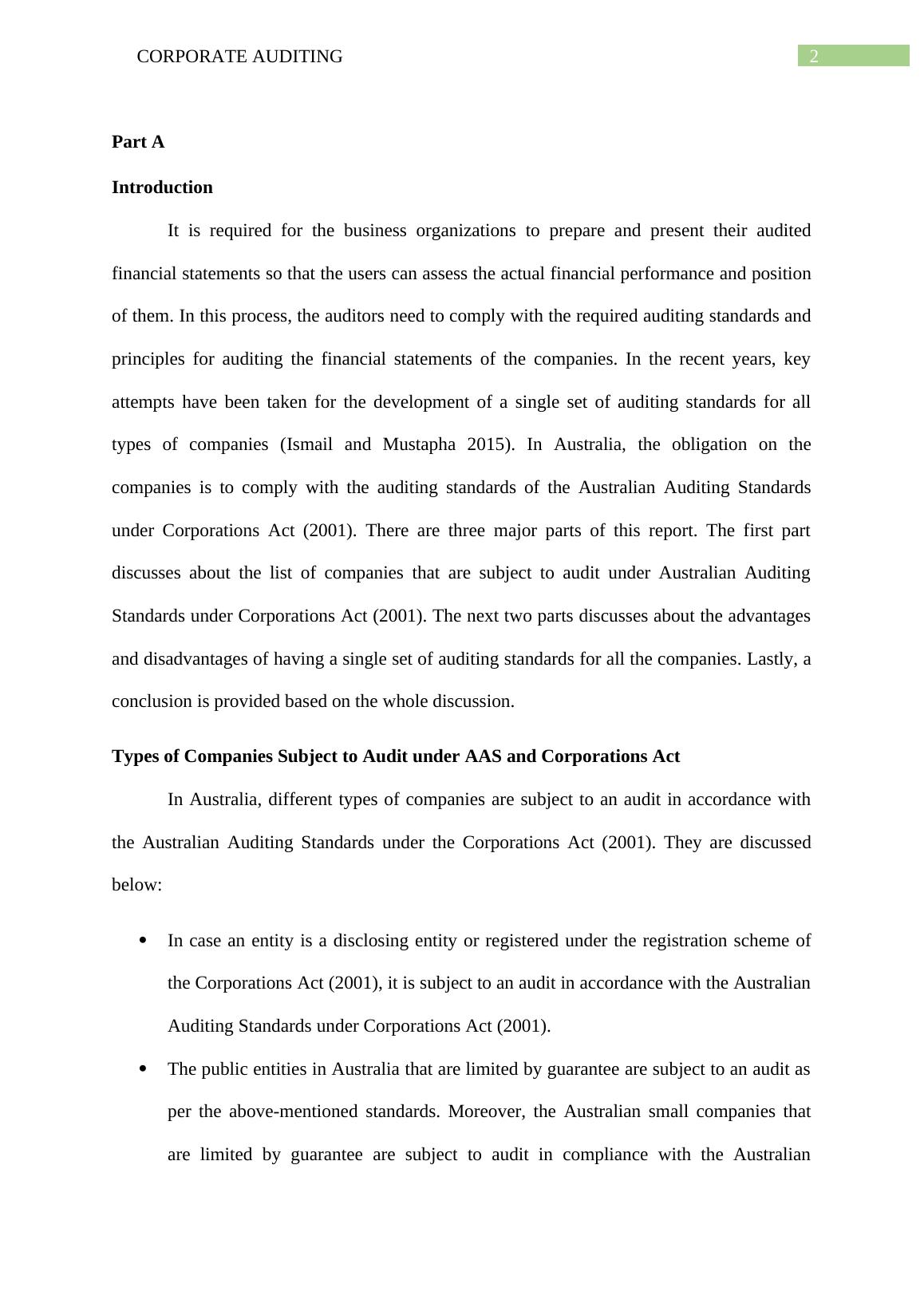
3CORPORATE AUDITING
Auditing Standards under the Corporations Act (2001). Australian small companies
limited by guarantee are subject to audit as per the Australian Auditing Standards
under the Corporations Act (2001) in case the ASIC or members request them to
prepare and audit a financial report (deloitte.com 2020).
The large proprietary companies in Australia that are also subject to an audit in
accordance with the same standards under the Corporations Act (2001) in case ASIC
has not granted them relief from the audit requirements of the Companies Act
(legislation.gov.au 2020).
The small proprietary companies in Australia along with the foreign controlled small
proprietary companies in Australia that have not received granted relief from the audit
requirements of the Corporations Act are subject to an audit in line with the
Australian Auditing Standards under the Corporations Act (2001).
The Australian small proprietary companies that are not controlled by foreign entities
need to consider the fact that whether the ASIC has requited them to prepare and audit
a financial statement. These types of small proprietary companies of Australian are
subject to an audit as per Australian Auditing Standards under the Corporations Act
(2001) in case the ASIC and their shareholders required their financial statements to
be audited (asic.gov.au 2020).
Therefore, it can be seen from the above that the business entities of Australia are
required to follow the rules and regulations of the Corporations Act (2001) under the ASIC in
order to be subject to an audit under Australian Auditing Standards.
Advantages of Company Audits Subject to One Set of Auditing Standards
Societies can get certain advantages of all the audit of all the companies are being
subject to a single set of Auditing Standards. Two of these advantages are discussed below:
Auditing Standards under the Corporations Act (2001). Australian small companies
limited by guarantee are subject to audit as per the Australian Auditing Standards
under the Corporations Act (2001) in case the ASIC or members request them to
prepare and audit a financial report (deloitte.com 2020).
The large proprietary companies in Australia that are also subject to an audit in
accordance with the same standards under the Corporations Act (2001) in case ASIC
has not granted them relief from the audit requirements of the Companies Act
(legislation.gov.au 2020).
The small proprietary companies in Australia along with the foreign controlled small
proprietary companies in Australia that have not received granted relief from the audit
requirements of the Corporations Act are subject to an audit in line with the
Australian Auditing Standards under the Corporations Act (2001).
The Australian small proprietary companies that are not controlled by foreign entities
need to consider the fact that whether the ASIC has requited them to prepare and audit
a financial statement. These types of small proprietary companies of Australian are
subject to an audit as per Australian Auditing Standards under the Corporations Act
(2001) in case the ASIC and their shareholders required their financial statements to
be audited (asic.gov.au 2020).
Therefore, it can be seen from the above that the business entities of Australia are
required to follow the rules and regulations of the Corporations Act (2001) under the ASIC in
order to be subject to an audit under Australian Auditing Standards.
Advantages of Company Audits Subject to One Set of Auditing Standards
Societies can get certain advantages of all the audit of all the companies are being
subject to a single set of Auditing Standards. Two of these advantages are discussed below:

4CORPORATE AUDITING
1. Strengthening the Audit Profession – The presence of one single set of auditing
standards play a crucial role in strengthening the audit profession as this one single set of
auditing standards largely contribute to the development of strong national and international
economies. It is possible to uplift the overall quality as well as consistency of the auditing
practices in the presence of a single set of auditing standards due to the follow of same
auditing standards by the auditors of all companies irrespective of size and industry (Nicoll
2016). This helps in addressing the complex audit issues in the most uniform manner so that
users of the audited financial statements of all companies can comprehend them easily. All
these aspects increase the trust of the common people on the audited financial statements that
eventually increases trust on the audit profession. In this manner, a single set of auditing
standards help to strengthen the audit profession for all the companies (Bryce, Ali and Mather
2015).
2. User-friendly Audit Reports – Users of the financial statements and regulators alike now
want more information as well as insight on the audited companies and its financial
statements. When there is major value of audit, many also believe that the reports of the
auditors need to communicate more information and insight on the financial performance and
position of the companies (Bryce, Ali and Mather 2015). This is not an open issue as this
indicates towards the question that whether the key risks of an entity need to be
communicated by the auditors. This leads to the need for change in the reports of the auditors
for catering to the needs of the users and regulators. In the presence of this issue, a single set
of audit standards put the same obligation on the auditors of all the companies to report on
the audit issue and key risks areas. This makes the audit reports user-friendly from where the
users can easily access the required information (Boolaky and Cooper 2015).
1. Strengthening the Audit Profession – The presence of one single set of auditing
standards play a crucial role in strengthening the audit profession as this one single set of
auditing standards largely contribute to the development of strong national and international
economies. It is possible to uplift the overall quality as well as consistency of the auditing
practices in the presence of a single set of auditing standards due to the follow of same
auditing standards by the auditors of all companies irrespective of size and industry (Nicoll
2016). This helps in addressing the complex audit issues in the most uniform manner so that
users of the audited financial statements of all companies can comprehend them easily. All
these aspects increase the trust of the common people on the audited financial statements that
eventually increases trust on the audit profession. In this manner, a single set of auditing
standards help to strengthen the audit profession for all the companies (Bryce, Ali and Mather
2015).
2. User-friendly Audit Reports – Users of the financial statements and regulators alike now
want more information as well as insight on the audited companies and its financial
statements. When there is major value of audit, many also believe that the reports of the
auditors need to communicate more information and insight on the financial performance and
position of the companies (Bryce, Ali and Mather 2015). This is not an open issue as this
indicates towards the question that whether the key risks of an entity need to be
communicated by the auditors. This leads to the need for change in the reports of the auditors
for catering to the needs of the users and regulators. In the presence of this issue, a single set
of audit standards put the same obligation on the auditors of all the companies to report on
the audit issue and key risks areas. This makes the audit reports user-friendly from where the
users can easily access the required information (Boolaky and Cooper 2015).
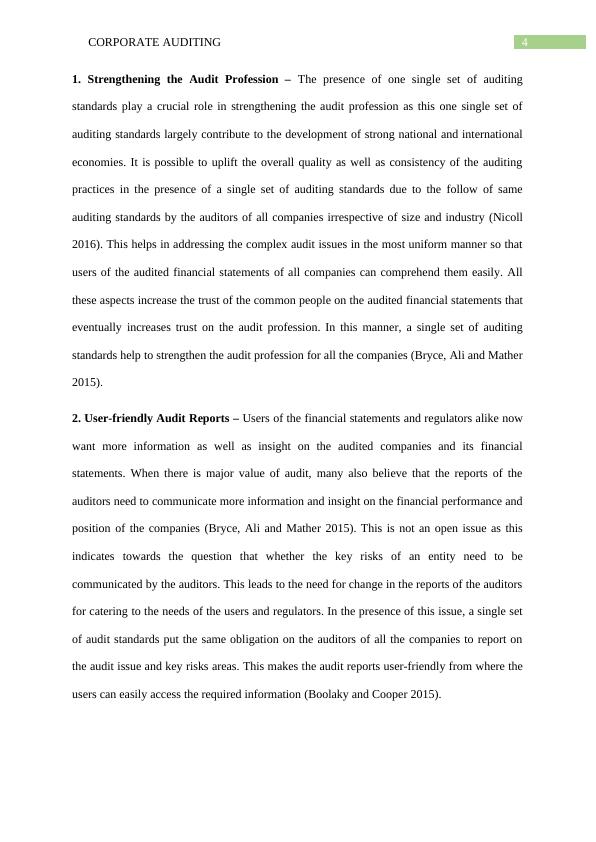
5CORPORATE AUDITING
Disadvantages of Company Audits Subject to One Set of Auditing Standards
Along with the advantages, there are certain disadvantages of the presence of a single
set of auditing standards for all the companies; and they are as below:
1. Concern of Standard Manipulation – One single standard of auditing for all the
companies provides the auditors with flexibility, but this has also a disadvantage. The
auditors can choose only the audit procedures they wish to incorporate in the auditing of the
companies and this allow them to provide favourable results to the audit clients (Simunic, Ye
and Zhang 2015). Therefore, the audited financial statements fail to demonstrate the actual
financial position and performance of the clients in the mort error-free manner. This situation
makes it easier for both the managements and auditors in incorporating revenue or profit
manipulation in the audit findings so that it become easier to hide the financial issues that
may exist. All these aspects together lead to fraudulent activities in the financial statements of
the companies; such as change the inventory valuation method for showing more income and
others (Fu, Carson and Simnett 2015).
2. Increased Cost of Audit – Before the introduction of a single set of auditing standards,
small companies were not required to prepare and audit their financial statements; but the
introduction of a single set of auditing standards has changed the scenario as now the small
companies are also required to prepare and audit the financial statements (Ferguson, Pinnuck
and Skinner 2016). It is easy for the large business organizations to absorb the cost of audit
like audit fees and others due to their huge income source, only the small business
organizations would feel the burden of these standards as they would be forced to prepare and
audit their financial statements that would cost them huge audit fees. This would create
negative impact on the financial resources of these small companies which would affect their
ability to generate sales and profit for long-term sustainability (Ferguson, Pinnuck and
Skinner 2016).
Disadvantages of Company Audits Subject to One Set of Auditing Standards
Along with the advantages, there are certain disadvantages of the presence of a single
set of auditing standards for all the companies; and they are as below:
1. Concern of Standard Manipulation – One single standard of auditing for all the
companies provides the auditors with flexibility, but this has also a disadvantage. The
auditors can choose only the audit procedures they wish to incorporate in the auditing of the
companies and this allow them to provide favourable results to the audit clients (Simunic, Ye
and Zhang 2015). Therefore, the audited financial statements fail to demonstrate the actual
financial position and performance of the clients in the mort error-free manner. This situation
makes it easier for both the managements and auditors in incorporating revenue or profit
manipulation in the audit findings so that it become easier to hide the financial issues that
may exist. All these aspects together lead to fraudulent activities in the financial statements of
the companies; such as change the inventory valuation method for showing more income and
others (Fu, Carson and Simnett 2015).
2. Increased Cost of Audit – Before the introduction of a single set of auditing standards,
small companies were not required to prepare and audit their financial statements; but the
introduction of a single set of auditing standards has changed the scenario as now the small
companies are also required to prepare and audit the financial statements (Ferguson, Pinnuck
and Skinner 2016). It is easy for the large business organizations to absorb the cost of audit
like audit fees and others due to their huge income source, only the small business
organizations would feel the burden of these standards as they would be forced to prepare and
audit their financial statements that would cost them huge audit fees. This would create
negative impact on the financial resources of these small companies which would affect their
ability to generate sales and profit for long-term sustainability (Ferguson, Pinnuck and
Skinner 2016).
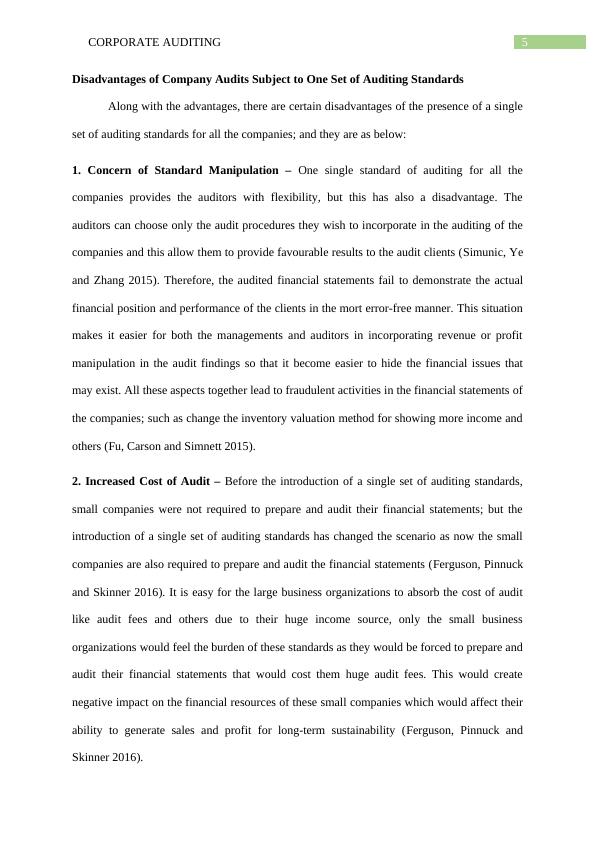
End of preview
Want to access all the pages? Upload your documents or become a member.
Related Documents
Essay on Corporations Actlg...
|11
|3251
|324
Rule and Regulations for ASX Listed Companies and Small Proprietary Companieslg...
|6
|1039
|133
Corporate Accounting: Financial Reporting and Regulations in Australialg...
|16
|3253
|131
Commercial and Corporation Law Assignment 2022lg...
|9
|2397
|18
Corporate Accounting Case Study Assignment on Small Business Guide and Financial Reporting Regulation in Australialg...
|5
|1790
|145
Corporate Accounting: Types of Companies, Financial Reporting Perspectives, and Control of Investeeslg...
|12
|2649
|124
